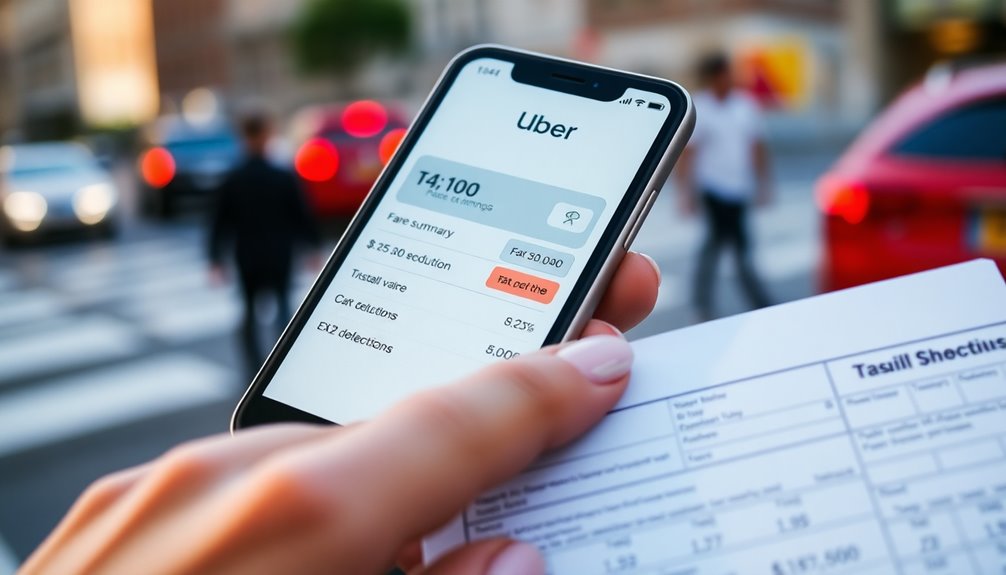Uber doesn't take out taxes from your earnings, so you're on your own when it comes to tax responsibilities. As an independent contractor, you'll need to report all your income, even if you don't receive tax forms. Uber provides a tax summary, but it's up to you to handle your tax payments. Keep in mind, you might need to make quarterly estimates if your annual tax liability exceeds $1,000. Plus, you can deduct certain business-related expenses to lower your taxable income. Want to learn how to manage your taxes effectively? There's much more to consider.
Key Takeaways
- Uber does not withhold taxes from driver earnings, as drivers are classified as independent contractors responsible for their own tax payments.
- A B-Notice from the IRS may trigger backup withholding at 24% if tax information is incorrect.
- Drivers must report all income, even without receiving tax forms, using Schedule C on Form 1040.
- Self-employment tax applies on net earnings over $400, covering Social Security and Medicare contributions.
- Quarterly estimated tax payments are required if annual liability exceeds $1,000 to avoid penalties.
Uber's Tax Withholding Policy

Uber's tax withholding policy clearly places the responsibility for taxes on drivers, who are classified as independent contractors rather than employees. This means you're in charge of your own tax payments, including federal and state income taxes.
Uber doesn't withhold any taxes from your earnings unless there's a problem with your tax information, like a mismatch with IRS records. It's important to address any issues promptly to avoid the consequences of a B-Notice, which can indicate a problem with your tax information.
If you receive a B-Notice due to incorrect details, such as your name or Taxpayer Identification Number (TIN), you'll need to resolve it promptly. If you don't, backup withholding of 24% might kick in, reducing your earnings until the issue is corrected.
To avoid this, make sure to update your tax information in Uber's Tax Settings. Once you provide the correct details, the backup withholding will stop, and you'll receive appropriate tax documents, like the 1099-K and Tax Summary.
Understanding Self-Employment Taxes

As an independent contractor, understanding self-employment taxes is vital for managing your finances effectively. Self-employment tax funds Social Security and Medicare and applies to your net earnings, which must exceed $400 in a year to be taxable. You report this tax on IRS Form 1040 Schedule SE, which reflects both the employee and employer portions of these taxes.
To calculate your self-employment tax, take 92.35% of your net earnings and multiply that amount by the self-employment tax rate of 15.3%. This rate consists of 12.4% for Social Security and 2.9% for Medicare. If your income surpasses $200,000, you may face additional Medicare taxes. Additionally, self-employed individuals are responsible for both the employee and employer portions of these taxes, which can significantly impact your overall tax liability.
You'll need to report your net profit or loss using Schedule C and include the self-employment tax in your annual Form 1040 filing. Remember, if you earn from multiple businesses, combine those earnings for tax purposes.
To avoid penalties, make estimated tax payments quarterly, which you can base on your previous year's tax return or simply set aside about 25% of your gross income. Keeping track of these responsibilities ensures you're prepared when tax season arrives.
Income Tax Responsibilities

When it comes to income tax responsibilities as an Uber driver, understanding what you need to report is essential for staying compliant with IRS regulations.
Uber provides a tax summary that details your total earnings from rides and other sources. If you meet specific thresholds, you'll receive Form 1099-K, which reflects your gross income, and Form 1099-NEC for any non-driving income, like referral bonuses. Remember, you must report all your Uber income to the IRS, even if you don't receive these forms.
When filling out your tax return, you'll use Schedule C (Profit or Loss From Business) of Form 1040. Here, list your gross earnings and deduct eligible business expenses, such as vehicle costs, tolls, and Uber fees, to determine your profit or loss. Uber drivers are classified as self-employed for tax purposes, which means they are responsible for handling their own income and expenses.
You can choose between the actual expenses method or the standard mileage method for car-related deductions. Keep a log to differentiate personal and business use of your vehicle.
Finally, accurate documentation is vital, as it ensures you report everything correctly and helps minimize your tax burden.
Making Quarterly Estimated Payments

Making quarterly estimated tax payments is crucial for Uber drivers to avoid unexpected tax bills at year-end. If you expect your annual tax liability to be at least $1,000, you must make these payments. If you didn't owe taxes last year and filed a standard return, you might be exempt.
For new drivers without a prior return, you can use the short form method or the 1040-ES worksheet to estimate your tax. To calculate your estimated payments, divide your previous year's total tax due by four, or set aside approximately 25% of your gross income. Remember, Uber doesn't withhold taxes for you, so it's your responsibility to make these payments. The quarterly payment due dates are April 15, June 15, September 15, and January 15 of the following year. If a due date falls on a weekend or holiday, make your payment on the next business day.
Keep accurate records of your income and expenses to avoid penalties or underpayment issues. Making regular payments helps you manage your finances better and reduces the risk of a hefty tax bill at the end of the year. Additionally, be aware that as an independent contractor, you are responsible for self-employment taxes which total 15.3%, covering Medicare and Social Security.
Stay proactive to ensure you're on top of your tax obligations!
Required Tax Forms and Documents

Navigating the tax landscape as an Uber driver requires a solid understanding of the essential forms and documents you'll need to file your taxes accurately.
First, you'll likely receive Form 1099-K, which summarizes your gross income if you've completed over 200 rides or earned more than $20,000. If you've made additional income, like bonuses or referral fees over $600, you'll get Form 1099-NEC to report that.
Next, you'll use Form 1040 for your individual tax return, attaching Schedule C to report your business income and expenses. Schedule C helps you determine your net profit or loss from your Uber activities. It's important to remember that Uber drivers are classified as independent contractors by the IRS, meaning you are responsible for your own taxes.
Uber also provides important documents like the Tax Summary by January 31st, detailing your income, expenses, and miles driven during the year. This summary is crucial for filling out your tax forms accurately.
Keep track of your receipts and bills for fuel and maintenance, as they'll help document your business expenses.
Lastly, if you're in Canada, make sure you have your Social Insurance Number and any necessary GST/HST numbers for accurate reporting.
Deductible Business Expenses

As an Uber driver, you can take advantage of various deductible business expenses that can significantly reduce your taxable income.
First, you can choose between the standard mileage rate of $0.67 per business mile driven in 2024 or the actual expense method to deduct vehicle-related costs like gas, maintenance, and depreciation. If you lease your vehicle, don't forget to deduct a portion of your lease payments based on business use. Vehicle-related expenses are often the largest deduction available to drivers, making accurate record-keeping essential.
In addition to vehicle expenses, you can also deduct costs related to your cell phone and internet, parking fees, and tolls incurred while driving.
Any supplies for your vehicle, such as emergency kits or cleaning supplies, are also deductible. If you provide food and drinks to riders, you can deduct 50% of those costs.
Furthermore, consider deducting platform fees, health insurance premiums, and retirement plan contributions.
If you have a home office, you can claim related expenses. Lastly, don't overlook business-related lodging, legal fees, and any roadside assistance plans.
Frequently Asked Questions
How Do I Track My Earnings as an Uber Driver?
To track your earnings as an Uber driver, you can use automated mileage tracking apps like MileIQ or Everlance.
These tools help you separate business from personal trips.
Also, consider maintaining an expense management system to log vehicle costs, fuel, and maintenance.
You can utilize spreadsheets for a comprehensive overview of your income and expenses.
Finally, keep all receipts organized digitally for easy access during tax season.
Can I Claim My Car as a Tax Deduction?
Yes, you can claim your car as a tax deduction if you're using it for business purposes.
You can choose between the Standard Mileage Rate or Actual Expenses method to calculate your deduction.
Keep a detailed mileage log, and track all related costs like fuel, maintenance, and insurance.
What Happens if I Miss a Quarterly Tax Payment?
If you miss a quarterly tax payment, you'll face penalties and interest charges that accumulate over time.
The IRS hits you with a 0.5% penalty on the amount owed each month, up to 25%. Even a minor delay can escalate costs, so it's crucial to pay as soon as you can.
If you can't pay the full amount, consider making a partial payment to reduce penalties and show your intent to settle.
Are There Any Tax Benefits for Rideshare Drivers?
Yes, there are several tax benefits for rideshare drivers like you.
You can deduct vehicle-related expenses, including mileage at 67 cents per mile or actual costs like gas and maintenance.
Additionally, you can deduct business-related costs like cell phone bills, apps, and even food provided to passengers.
Keeping accurate records of your income and expenses will help maximize your deductions, reducing your overall tax burden significantly.
How Can I Estimate My Annual Tax Liability?
To estimate your annual tax liability, start by calculating your total income from all sources, including wages, tips, and any side gigs.
Next, subtract any deductions and exemptions you're eligible for, like business expenses or standard deductions.
Then, apply the relevant federal and state tax rates to your taxable income.
Don't forget to consider any tax credits that might reduce your liability.
Keeping accurate records throughout the year will help streamline this process.
Conclusion
In conclusion, Uber doesn't automatically withhold taxes from your earnings, so you need to be proactive about your tax responsibilities. As a self-employed driver, you'll have to pay self-employment taxes and make quarterly estimated payments to avoid penalties. Keep track of your income and deductible business expenses to help reduce your tax burden. By staying informed and organized, you can navigate the tax process smoothly and ensure you're meeting all your obligations.









